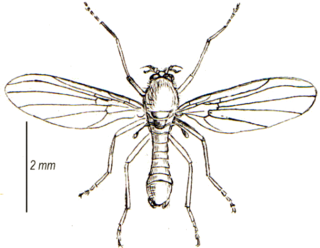Related Research Articles

The Chironomidae comprise a family of nematoceran flies with a global distribution. They are closely related to the Ceratopogonidae, Simuliidae, and Thaumaleidae. Many species superficially resemble mosquitoes, but they lack the wing scales and elongated mouthparts of the Culicidae. An example of mosquito-resembling species is Tokunagayusurika akamusi.

Thaumaleidae, the solitary midges or trickle midges, are a group of nematoceran flies related to the Ceratopogonidae, Chironomidae, and the Simuliidae. They are small, stocky, yellow to brown flies (3–4 mm). Very few species are known for this family. Larvae are found in films on rocks and the nonfeeding adults are usually found on foliage along the same streams in which the larvae are found. A few solitary midges are found in the Southern Hemisphere, but Thaumaleidae are generally an Holarctic family.
Antillocladius is a genus of midges belonging to the family Chironomidae, subfamily Orthocladiinae. The name Antillocladius means orthoclad that occurs in the Antilles, where it was primarily recorded.
Qiniella is a genus of non-biting midges in the diptera subfamily Orthocladiinae of the family Chironomidae.

The genus Axarus is widely distributed with records from the Holarctic, the Neotropics and Australasia . There are currently 5 described nearctic species . Erected as a subgenus (Anceus) of Xenochironomus , Axarus was subsequently renamed and elevated to generic status . The Connecticut River in the eastern United States harbors locally dense populations of two Axarus species, both currently undescribed. These populations are interesting in that they are restricted to specific larval habitat and thus there is genetic structure between populations in the river . The Connecticut River species are also notable in that they have extremely well developed polytene chromosomes and also maintain a high degree of inversion polymorphism .
Arctodiamesa is a genus of non-biting midges in the subfamily Diamesinae of the bloodworm family Chironomidae.
Apedilum is a genus of non-biting midges of the bloodworm family Chironomidae. The genus was previously considered a junior synonym of Paralauterborniella, but was restored as a separate genus by J. H. Epler (1988) for the species A. elachistus and A. subcinctum.
Corynoneura is a speciose genus of non-biting midges in the subfamily Orthocladiinae of the bloodworm family Chironomidae. With a world-wide distribution, these small midges are found in both flowing and standing freshwater of various thermal regimes.
Gymnometriocnemus is a genus of non-biting midges in the subfamily Orthocladiinae of the bloodworm family (Chironomidae). The genus is divided into two subgenera, Raphidocladius Sæther 1983 and Gymnometriocnemus Goetghebuer, 1932. Males of the former subgenus are characterized by possessing an extremely long virga with needle-like sclerotization, species of the later characterized by a short virga and a weakly developed crista dorsalis in the adult male hypopygium.

Chironomus is a genus of nonbiting midges in the subfamily Chironominae of the bloodworm family, Chironomidae, containing several cryptic species that can only be distinguished by experts based on the characteristics of their giant chromosomes. The larvae of several species inhabit the profundal zone where they can reach relatively high densities. They use a combination of hemoglobin-like proteins and undulatory movements in their burrows to obtain oxygen in poorly oxygenated habitats.

Chironominae is a subfamily of midges in the non-biting midge family (Chironomidae).
Beckidia is a genus of European and African non-biting midges in the subfamily Chironominae of the bloodworm family Chironomidae.
Zavrelia is a genus of European non-biting midges in the subfamily Chironominae of the bloodworm family Chironomidae.
Paralauterborniella is a genus of non-biting midges in the subfamily Chironominae of the bloodworm family Chironomidae. Apedilum was formerly considered a junior synonym of this genus, but was restored as a separate genus by J. H. Epler (1988) for the species A. elachistus and A. subcinctum.
Pentaneurini is a tribe of midges in the non-biting midge family (Chironomidae).
Diamesinae is a subfamily of midges in the non-biting midge family (Chironomidae).
Diamesini is a tribe of midges in the non-biting midge family (Chironomidae).
Pagastia is a genus of non-biting midges in the subfamily Diamesinae of the bloodworm family Chironomidae.
Afrozavrelia is a genus of European non-biting midges in the subfamily Chironominae of the bloodworm family Chironomidae that are closely related to Zavrelia.

Pontomyia is a genus of flightless marine midges belonging to the subfamily Chironominae in the Chironomidae family. Insects in marine environments are extremely rare while flightlessness, extreme sexual dimorphism, and an extremely short adult life span contribute to making these midges unusual among insects. They are known from the shores of islands in the Indian, Atlantic and Pacific Oceans.
References
- ↑ Cranston, Peter S. (2017). "A new genus and species of Australian Tanypodinae (Diptera: Chironomidae) tolerant to mine waste". Zootaxa. 4263: 369–377.
| | This article related to members of the fly family Chironomidae is a stub. You can help Wikipedia by expanding it. |